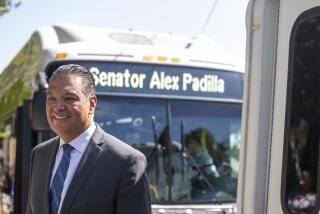Will Carpool Lanes Lose Zip if Electric Cars Charge In?
- Share via
Dear Street Smart:
I am one who is looking forward to an electric car. But one question: Have the government authorities taken steps to allow electric cars to use the carpool lanes? It’s a logical step. Your column has pointed out that the carpool lanes are to encourage the use of fuel-efficient vehicles. The availability of carpool lanes would be a useful incentive for people to buy electric cars.
F.E.P. Whitehead
Irvine
Assemblyman Wally Knox (D-Los Angeles) agrees with you. He has introduced a bill, AB2282, that would allow low-emission vehicles, including electric cars, to use carpool lanes. The bill, which has bipartisan support, already has cleared the Assembly Transportation Committee and is expected to reach the Assembly floor this week.
“We are at a stalemate currently on moving ahead with incentives for low-emission vehicles,” Knox said. “I believe it’s a good time to find some incentives to keep the topic on the table. We think this will create an incentive for a variety of people to go out and get low-emission vehicles.”
However, electric cars have a maximum speed of 55-60 mph which, according to Pat Ryan, a spokeswoman for the California Highway Patrol, is a potential problem.
“I know that electric cars don’t go very fast,” she said, “and part of the purpose of the carpool lane is to expedite traffic. It could slow things down.”
Victor Dea, a manager for the National Highway Traffic Safety Administration in San Francisco, said that while engineers are constantly trying to make them go faster, electric cars are “not necessarily perfected. It depends on what technology allows them to do in the future.”
Caltrans hasn’t taken a position on the bill, but the agency has a history of opposing efforts to open carpool lanes to vehicles with one occupant. “If we let too many cars into the carpool lanes,” spokesman Russell Snyder said, “it could really jam them up and reduce their effectiveness.”
The only California carpool lane that allows electric cars with one person is on the 91 Express, the new privately operated toll road in Orange County. Electric cars equipped with transponders can use that road for free.
Dear Street Smart:
Lately I’ve heard on the radio about traffic tie-ups caused by a Smog Cam.
I’ve never been in the right place at the right time to experience such a tie-up, but I’m curious--what does a Smog Cam look like, and why does it affect traffic flow so severely?
Mary McClure
Mission Viejo
Smog Cams are remote sensing devices that electronically detect high smog emissions from the tailpipes of passing vehicles.
They consist of two black toaster-sized boxes mounted on tripods, one on each side of an onramp. As a vehicle passes, one box emits an infrared beam through the vehicle’s exhaust to the other, which “reads” it and sends the data to a computer in an adjacent horse-sized trailer. Based on the amount of light deflected by the exhaust gasses, the computer can analyze the contents of the exhaust.
Besides the two infrared boxes and the adjacent trailer, drivers are likely to see the truck that hauls the trailer and a nearby high-speed video camera that records license numbers for later identification.
For the past six months, the Department of Consumer Affairs has been testing 10 of the devices statewide, including one in Orange County that is stationed at a different onramp every day. Beginning this summer, the state will begin sending letters to the owners of vehicles found with high emissions, requiring them to get their vehicles tested and fixed.
But reports of Smog Cams causing traffic tie-ups are greatly exaggerated, according to Maria Chacon Kniestedt, a spokeswoman for the California Department of Consumer Affairs. In fact, Kniestedt said, she and other department representatives will be meeting with Southern California radio traffic reporters this week to drive home that point.
“There have been lots of [media] reports in Southern California that these devices have been slowing up traffic,” Kniestedt said. “We were very concerned.”
After checking into it, she said, officials determined that most of the tie-ups were caused by nearby accidents or road work. And in some cases, she said, the traffic reporters themselves had contributed to the slowdowns by reporting the presence of the roadside smog detectors.
“By drawing attention to them, they may be causing rubbernecking,” she said.
*
You may have noticed Caltrans workers wearing orange ribbons Friday. Caltrans vehicles also were driven with their headlights on that day. It was part of a statewide observance of Workers Memorial Day, commemorating in part three Caltrans workers who were killed on freeways last year.
While no highway workers have been killed in Orange County, Caltrans officials say, a worker on the Orange Freeway was struck and seriously injured. And statewide, they say, working on the highways is more dangerous than being a California Highway Patrol officer. Since 1972, according to state statistics, 145 Caltrans workers have been killed on the job, compared to 50 CHP officers.
Street Smart appears Mondays in The Times Orange County Edition. Readers are invited to submit comments and questions about traffic, commuting and what makes it difficult to get around in Orange County. Include simple sketches if helpful. Letters may be published in upcoming columns. Please write to David Haldane, c/o Street Smart, The Times Orange County, P.O. Box 2008, Costa Mesa, CA 92626, send faxes to (714) 966-7711 or e-mail him at David.Haldane@latimes.com Include your full name, address and day and evening phone numbers. Letters may be edited, and no anonymous letters will be accepted.
More to Read
Sign up for Essential California
The most important California stories and recommendations in your inbox every morning.
You may occasionally receive promotional content from the Los Angeles Times.













